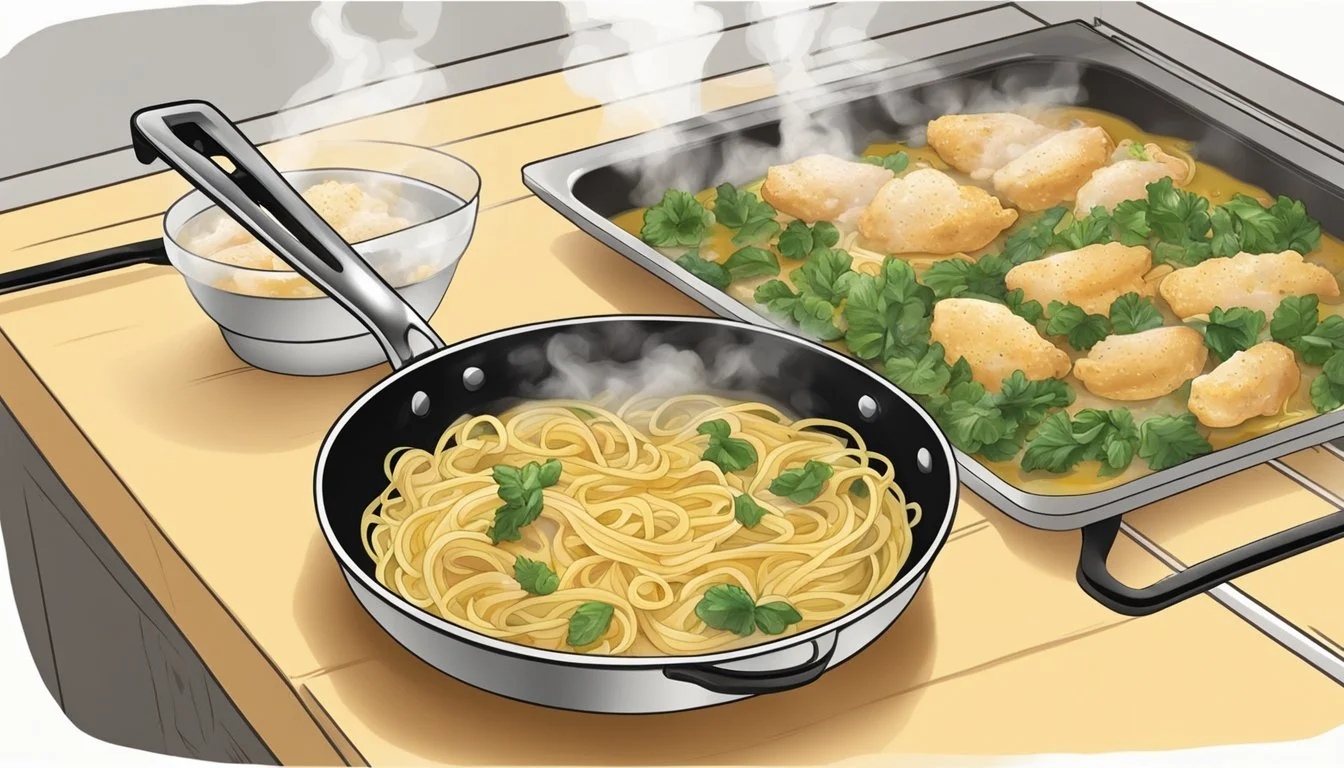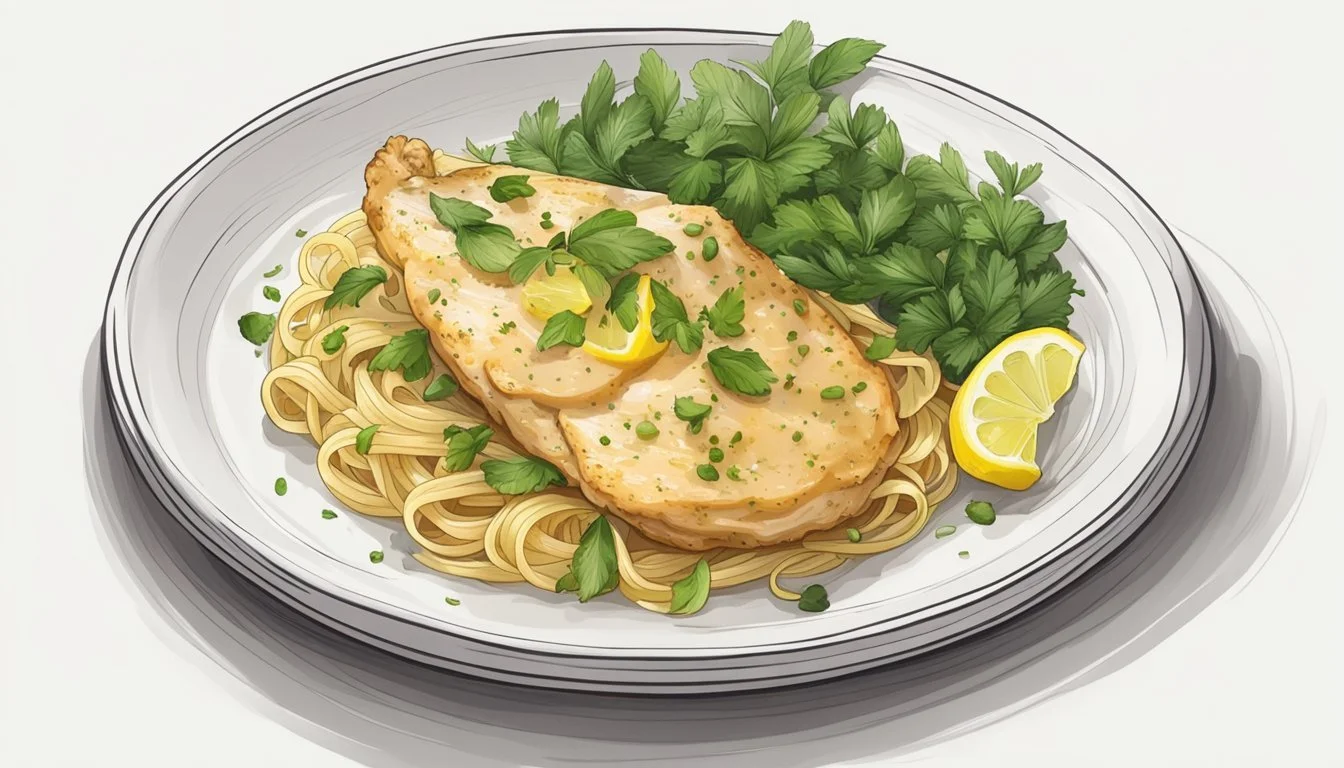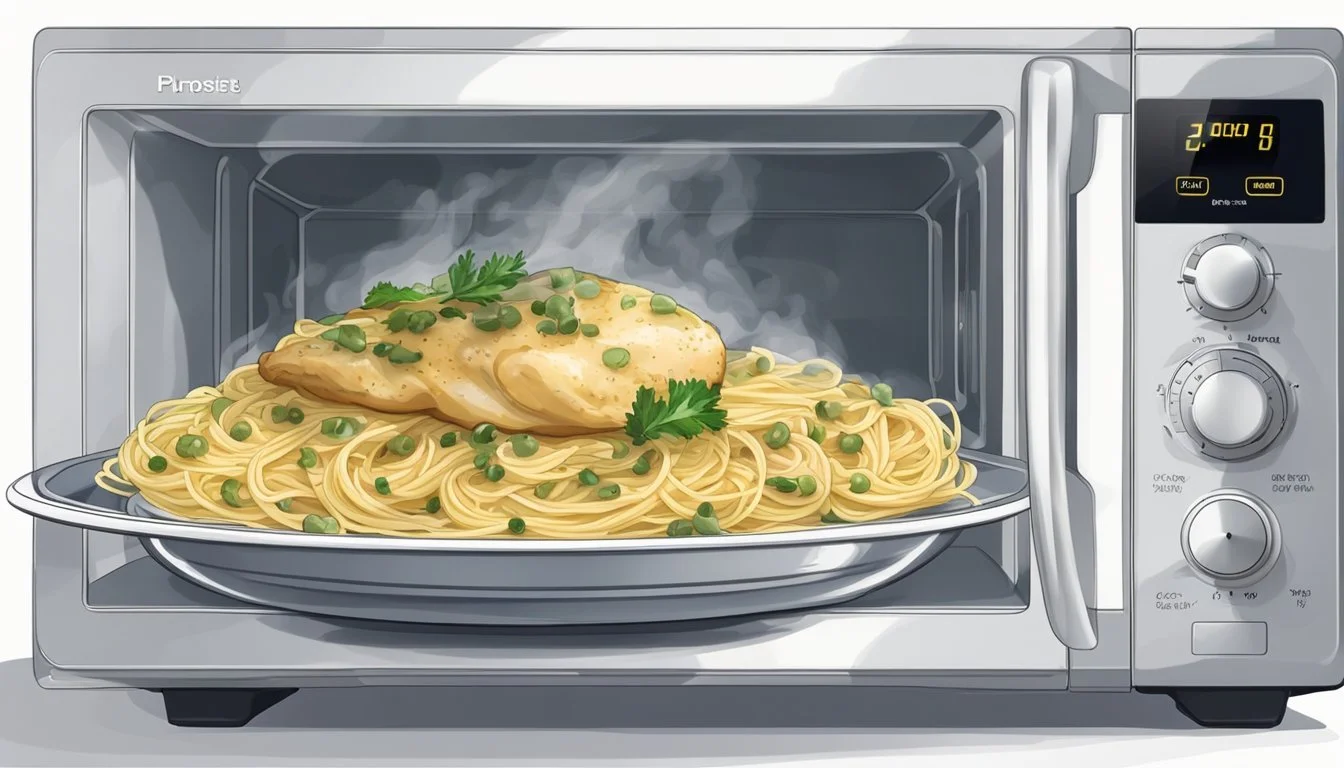How to Reheat Chicken Piccata with Pasta
Expert Tips for Perfect Results
For those who savor the delightful tang of chicken piccata but find themselves mulling over the best way to enjoy their leftovers, this guide offers clear, practical solutions. Reheating chicken piccata with pasta doesn't have to be a challenging task; with the right methods, you can retain its savory flavors and moist texture. Whether you prefer stovetop or microwave techniques, or even exploring less conventional methods like an air fryer, ensuring your meal tastes just as good as when it was freshly made is essential.
To kick off, consider stovetop reheating. Heat a skillet over medium heat, adding oil and butter to revive the chicken's original zest. Carefully place the leftover chicken piccata into the pan, stirring occasionally, and remember to add a splash of lemon juice for that signature tang. Not only does this method enhance the flavor, it also helps maintain the chicken's tender quality.
For those pressed for time, microwave reheating can be effective. Place the chicken piccata in a microwave-safe bowl, cover it with plastic wrap, and heat on medium power. Ensure to let it sit for a couple of minutes post-heating to allow the temperature to evenly distribute. For an extra touch, a bit of water or broth can be added to ensure the pasta remains moist. This straightforward approach provides a quick and easy way to enjoy your chicken piccata leftovers without sacrificing on taste.
Understanding Chicken Piccata
Chicken Piccata is a classic Italian dish known for its tender chicken breast, tangy lemon juice, and briny caper sauce. The combination of savory, mildly sour, and rich flavors creates a delightful culinary experience. Accompanying the chicken with pasta enhances the dish by providing a complementary texture and taste.
Components of Chicken Piccata
Chicken Piccata typically features thinly sliced chicken breasts that are lightly dredged in flour. This step gives the chicken a slight crust when cooked.
Lemon juice plays a crucial role by adding a distinct tartness that balances the richness of the butter used in the sauce. Capers contribute a salty note, making each bite more flavorful.
The recipe often includes garlic and white wine, which deepen the flavor profile. Cooking the chicken in a combination of olive oil and butter adds richness and helps develop a beautiful golden color on the meat.
The Role of Pasta in Chicken Piccata
Pasta, commonly spaghetti or angel hair, serves as an excellent base for Chicken Piccata. The mild flavor and tender texture of the pasta allow the bold flavors of the chicken and sauce to shine.
When preparing pasta for this dish, it is often cooked until al dente to provide a slight bite that contrasts with the tender chicken.
Tossing the cooked pasta in the lemon-butter sauce ensures it absorbs the flavorful essence of the dish. Enhancing the pasta with a touch of freshly grated Parmesan cheese can add depth and an extra layer of richness.
Using pasta not only makes the meal more filling but also helps in soaking up the delicious sauce, ensuring that no flavor is wasted.
Preparation Before Reheating
Proper preparation ensures that the chicken piccata and pasta remain flavorful and safe to consume after reheating. It's essential to store leftovers correctly and consider important factors before reheating.
Proper Storage Techniques
Proper storage is crucial for maintaining the quality of leftover chicken piccata. Place the chicken piccata and pasta in airtight containers or freezer bags to prevent contamination and preserve moisture.
If storing in the refrigerator, use sealed containers and ensure the temperature is set below 40°F (4°C).
For longer storage, freezing is a viable option. To freeze, divide the chicken piccata and pasta into manageable portions. Place them in freezer bags and remove as much air as possible to avoid freezer burn. Label the bags with the date before placing them in the freezer.
Pre-Reheating Considerations
Before reheating, allow the leftovers to sit at room temperature for about 10-15 minutes. This helps the chicken and pasta reheat more evenly.
Preheat your skillet or oven to the desired temperature. If using a skillet, add oil or butter and wait until it’s hot enough before adding the chicken piccata.
If you opt for the oven, preheat it to around 350°F (175°C). Place the chicken piccata in an oven-safe dish and cover it with foil to retain moisture. For microwave reheating, a splash of lemon juice or broth can help keep the dish from drying out.
Finally, check that the internal temperature of the chicken reaches 165°F (74°C) to ensure it's safe to eat.
Reheating Methods
Reheating chicken piccata with pasta effectively is crucial to maintain its flavors and texture. Different methods can be used to achieve even heat distribution and a pleasant dining experience.
Oven Reheating
To reheat chicken piccata in the oven, preheat the oven to 350°F (175°C). Place the chicken piccata and pasta in a baking dish. Add a splash of broth or water to keep the dish moist. Cover the dish with aluminum foil. Bake it for 15-20 minutes, checking occasionally to ensure the dish does not dry out. This method ensures even heat distribution and helps retain a crispy texture on the chicken.
Stovetop Reheating
For stovetop reheating, use a skillet over medium heat. Add a small amount of oil or butter to the pan. Place the chicken piccata and pasta in the skillet in a single layer. Stir gently and frequently to promote even heating. You can add lemon juice or broth for additional moisture and flavor. This method is efficient for maintaining the dish's original taste and texture.
Microwave Reheating
Microwave reheating is quick and convenient. Place the chicken piccata and pasta in a microwave-safe dish. Add a bit of broth to prevent drying. Cover the dish with microwave-safe plastic wrap or a lid with a vent. Heat the dish on medium power for 2-3 minutes. Let it sit for 1-2 minutes after reheating to allow the heat to distribute evenly.
Alternative Equipment
Other options include air fryers, toaster ovens, and slow cookers. Air fryers can be preheated to 350°F (175°C); cook the chicken piccata for 3-4 minutes, or until heated through. Toaster ovens can also be set to similar temperatures and timings as conventional ovens. Slow cookers, on the other hand, provide gentle, even heat but require longer reheating times, typically around 1-2 hours on a low setting. These methods offer flexibility and efficiency, depending on the equipment available.
Best Practices for Reheating
To enjoy leftover chicken piccata with pasta at its best, follow these key practices. Focus on retaining moisture and flavor, maintaining texture, and ensuring even heating.
Retaining Moisture and Flavor
Reheating chicken piccata without drying out the meat and sauce is crucial. Add a little broth or water to the saucepan to keep the dish moist. Covering the pan with a lid helps trap moisture. Use olive oil or butter to refresh the sauce and enhance its flavor.
For added zest, squeeze some lemon juice and sprinkle fresh parsley over the top before serving. This keeps the original flavors intact and lively. Salt and pepper can be added to taste if the flavors need a boost.
Maintaining Texture
Keeping the chicken's crispy texture is important. If reheating in an oven, preheat to 250°F and place the chicken on a baking sheet. Cover with foil to avoid drying out, and bake for around 30 minutes.
Using the stovetop method, lightly fry the chicken again in a touch of olive oil or butter. This method ensures the chicken remains crispy. Avoid overcrowding the pan to maintain even heat distribution, which is essential for crisp texture.
Ensuring Even Heating
For even heating, avoid the microwave, as it can cause uneven spots and overcook the chicken. Instead, use an oven or stovetop method. When using the stovetop, reheat on low to medium heat and stir the pasta and sauce occasionally.
Using a heavy-bottomed saucepan or skillet can also help distribute heat more evenly and prevent hotspots. Always ensure the chicken and pasta are heated through to 165°F to guarantee it is safe to eat.
Employing these methods ensures your reheated chicken piccata retains its flavorful essence, tender chicken, and well-distributed heat.
Serving and Presentation
When serving chicken piccata with pasta, it is crucial to consider both the accompaniments and the garnishing touches. Thoughtfully prepared side dishes and well-executed presentation can elevate the meal, making it appealing and complete.
Accompaniments and Side Dishes
A variety of side dishes can complement chicken piccata and pasta. Traditional Italian choices such as garlic bread or a light Caesar salad are excellent. Garlic bread can be prepared by spreading minced garlic and butter on slices of Italian bread, then toasting them until golden.
For a more robust option, consider serving a side of steamed vegetables like broccoli or asparagus. These vegetables can be lightly seasoned with lemon and olive oil to enhance the flavors. Another option is a simple risotto or Italian-style rice, which pairs well with the lemony sauce of the chicken piccata.
Garnishing and Final Touches
Proper garnishing adds visual appeal and enhances the flavor of the chicken piccata. Fresh parsley is a traditional choice, finely chopped and sprinkled over the dish. This gives a burst of color and a subtle herbaceous note. Additionally, thin lemon slices or wedges can be placed around the edge of the plate for an added citrus aroma and decorative element.
Sprinkling parmesan cheese over the pasta can add a savory richness to the meal. For an elegant touch, drizzle a little extra virgin olive oil over the chicken and pasta just before serving. This not only adds shine but also depth of flavor.
Additional Tips
Reheating chicken piccata with pasta can be optimized by utilizing leftovers creatively and following important food safety considerations.
Utilizing Leftovers Creatively
Leftover chicken piccata and pasta can be transformed into entirely new dishes. For a quick fix, consider combining the leftovers into a chicken piccata pasta salad. Add fresh vegetables like cherry tomatoes, olives, and baby spinach. Toss with a light lemon vinaigrette to enhance the existing flavors.
Alternatively, create a chicken piccata sandwich by placing the reheated chicken cutlet in a baguette with some arugula and a dollop of aioli. Shredding the leftover chicken and mixing it with pasta, Parmesan, and a bit of cream can turn into a delicious pasta bake.
Food Safety Considerations
Always ensure that the leftovers are stored properly in the refrigerator. Chicken piccata and pasta should be stored in an airtight container and consumed within three to four days.
When reheating, the internal temperature of the chicken should reach at least 165°F (74°C) to ensure safety. Avoid reheating multiple times as it increases the risk of bacterial growth. If using a microwave, ensure even heating by stirring the dish halfway through the process.
Refrigerated leftovers should not be left at room temperature for more than two hours to prevent foodborne illnesses.
Conclusion
Reheating chicken piccata with pasta can be done effectively using various methods.
A skillet over medium heat is great. Heat the chicken piccata with a bit of oil and butter. Add in garlic to enhance flavor. Cooking 2-3 minutes per side is usually sufficient.
The microwave is convenient. Place chicken piccata in a microwavable dish. Add a little broth and cover with plastic wrap. Heat on medium power for up to 2 minutes.
Sous vide is another method. Seal the chicken piccata in a vacuum bag and cook in a sous vide bath at 145°F (63°C) for 30-45 minutes. This maintains moisture and texture.
An air fryer preheated to 350°F (175°C) can also be used. Cook for 3-4 minutes until thoroughly reheated.
Adding a splash of white wine can enhance the flavors. Ensure the dish has adequate moisture by including liquids like broth. Proper seasoning with salt and pepper is also key.
These methods ensure that your chicken piccata with pasta is heated through while maintaining quality.






